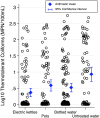Microbiological Evaluation of Household Drinking Water Treatment in Rural China Shows Benefits of Electric Kettles: A Cross-Sectional Study
- PMID: 26421716
- PMCID: PMC4589372
- DOI: 10.1371/journal.pone.0138451
Microbiological Evaluation of Household Drinking Water Treatment in Rural China Shows Benefits of Electric Kettles: A Cross-Sectional Study
Abstract
Background: In rural China ~607 million people drink boiled water, yet little is known about prevailing household water treatment (HWT) methods or their effectiveness. Boiling, the most common HWT method globally, is microbiologically effective, but household air pollution (HAP) from burning solid fuels causes cardiovascular and respiratory disease, and black carbon emissions exacerbate climate change. Boiled water is also easily re-contaminated. Our study was designed to identify the HWT methods used in rural China and to evaluate their effectiveness.
Methods: We used a geographically stratified cross-sectional design in rural Guangxi Province to collect survey data from 450 households in the summer of 2013. Household drinking water samples were collected and assayed for Thermotolerant Coliforms (TTC), and physicochemical analyses were conducted for village drinking water sources. In the winter of 2013-2104, we surveyed 120 additional households and used remote sensors to corroborate self-reported boiling data.
Findings: Our HWT prevalence estimates were: 27.1% boiling with electric kettles, 20.3% boiling with pots, 34.4% purchasing bottled water, and 18.2% drinking untreated water (for these analyses we treated bottled water as a HWT method). Households using electric kettles had the lowest concentrations of TTC (73% lower than households drinking untreated water). Multilevel mixed-effects regression analyses showed that electric kettles were associated with the largest Log10TTC reduction (-0.60, p<0.001), followed by bottled water (-0.45, p<0.001) and pots (-0.44, p<0.01). Compared to households drinking untreated water, electric kettle users also had the lowest risk of having TTC detected in their drinking water (risk ratio, RR = 0.49, 0.34-0.70, p<0.001), followed by bottled water users (RR = 0.70, 0.53-0.93, p<0.05) and households boiling with pots (RR = 0.74, 0.54-1.02, p = 0.06).
Conclusion: As far as we are aware, this is the first HWT-focused study in China, and the first to quantify the comparative advantage of boiling with electric kettles over pots. Our results suggest that electric kettles could be used to rapidly expand safe drinking water access and reduce HAP exposure in rural China.
Conflict of interest statement
Figures




References
-
- Ramanathan V, Carmichael G. Global and regional climate changes due to black carbon. Nature Geosci. 2008;1(4):221–7.
Publication types
MeSH terms
Substances
LinkOut - more resources
Full Text Sources
Other Literature Sources
Medical
Research Materials

